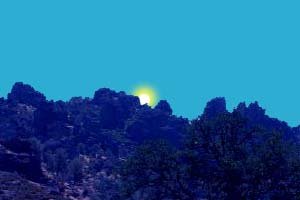 The Sun in the act of crossing the horizon.I received an email from a man who wanted to know if there was any truth to the claim that, in the last few years, the tilt of Earth's axis had shifted by three degrees, and that there was a great cover-up to hide the fact from the populace.
The Sun in the act of crossing the horizon.I received an email from a man who wanted to know if there was any truth to the claim that, in the last few years, the tilt of Earth's axis had shifted by three degrees, and that there was a great cover-up to hide the fact from the populace.
The inquirer wanted a scientific response—that he was a history major, and was having some difficulty trying to debunk the rumor with someone he knew.
I explained that, no, I knew of no evidence to support the claim. To the contrary, Earth's North Pole was still pointing less than a degree away from the trusty North Star, Polaris, as it had been, more or less, for hundreds of years, still serving as the same constant marker of north today as it had been for seafaring navigators long ago. Had Earth's axis shifted by three degrees—in any direction—Polaris would consequently have moved far enough of the mark of the Celestial Pole for all to see—those who cared to look closely, at any rate. Certainly not something that a cover-up could keep secret. Seasonal conditions, too, would be affected, for all to experience.
I was thanked, and told that the explanation might be enough to assuage the concerns of the writer's acquaintance.
The next day I got an email from the acquaintance—actually, brother—a man in Missouri. I was told firmly—though politely—that I must be wrong, for he had seen the evidence with his own eyes: after a lifetime of knowing the Sun rises precisely in the east, one morning not long ago, he suddenly observed the Sun to rise quite a distance to the north of east.
